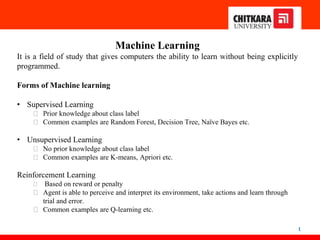
Lec 18-19.pptx
- 1. 1 Machine Learning It is a field of study that gives computers the ability to learn without being explicitly programmed. Forms of Machine learning • Supervised Learning ⮚ Prior knowledge about class label ⮚ Common examples are Random Forest, Decision Tree, Naïve Bayes etc. • Unsupervised Learning ⮚ No prior knowledge about class label ⮚ Common examples are K-means, Apriori etc. Reinforcement Learning ⮚ Based on reward or penalty ⮚ Agent is able to perceive and interpret its environment, take actions and learn through trial and error. ⮚ Common examples are Q-learning etc.
- 2. Decision Tree Learning • Decision tree learning is a method for approximating discrete-valued target functions. • The learned function is represented by a decision tree. ⮚ A learned decision tree can also be represented as a set of if-then rules. • Decision tree learning is one of the most widely used and practical methods for inductive inference. • It is robust to noisy data and capable of learning disjunctive expressions. • Decision tree learning method searches a completely expressive hypothesis. ⮚ Avoids the difficulties of restricted hypothesis spaces. ⮚ Its inductive bias is a preference for small trees over large trees. • The decision tree algorithms such as ID3, C4.5 are very popular inductive inference algorithms, and they successfully applied to many leaning tasks.
- 3. Decision Tree • Decision Tree represents a disjunction of conjunctions of constraints on the attributes values of instances. • Each path from the tree root to a leaf corresponds to a conjuction of attribute tests • The tree itself is a disjunction of these conjunctions. (Outlook = Sunny ˄ Humidity = Normal) ˅ (Outlook = Overcast) ˅ (Outlook = Rain ˄ Wind = Weak )
- 4. Decision Tree • Decision tree classify instances by sorting them down the tree from the root to some leaf node, which provides the classification of the instance. • Each node in the tree specifies a test of some attributes of the instance. • Each branch descending from a node corresponds to one of the possible values for the attribute. • Each leaf node assigns a classification. • The instance (Outlook = Sunny, Temperature = Hot, Humidity = High, Wind = Strong) is classified as a negative instance. 4
- 5. Which Attribute is “best”? • We would like to select the attribute that is most useful for classifying examples. • Information Gain measures how well a given attribute separates the training examples according to their target classification. • ID3 uses this information gain measure to select among the candidate attribute at each step while growing the tree. • In order to define information gain precisely, we use a measure commonly used in information theory, called entropy • Entropy characterizes the (im)purity of an arbitrary collection of examples. 5
- 6. • 6
- 7. • 7
- 8. Which attribute is best classifier? 8
- 9. ID3 Training examples – [9+, 5-] 9
- 10. ID3 Selecting Next Attribute 10
- 11. ID3 Selecting Next Attribute 11
- 12. ID3 Selecting Next Attribute 12
- 13. Best Attribute - Outlook 13
- 14. • 14
- 15. ID3 - Result 15
- 16. Converting Decision Tree into Rules 16
- 18. Linear Models A strong high-bias assumption is linear separability: – in 2 dimensions, can separate classes by a line – in higher dimensions, need hyperplanes A linear model is a model that assumes the data is linearly separable 18
- 19. A linear model in n-dimensional space (i.e. n features) is define by n+1 weights: In two dimensions, a line: In three dimensions, a plane: In m-dimensions, a hyperplane 19 (where b = - a)
- 20. Artificial Neural Network (ANN) • Artificial Neural Network (ANNs) are programs designed to solve any problem by trying to mimic the structure and the function of our nervous system. • Neural networks are based on simulated neuron, which are joined together in a variety of ways to form networks. • Neural network resembles human brain in the following two ways ⮚ A neural network acquires knowledge through learning ⮚ A neural network’s knowledge is stored within the interconnection strengths known as synaptic weights. 20
- 21. • 21
- 22. • 22
- 23. 23
- 24. 24
- 25. 25
- 26. Backpropagation Algorithm • The backpropagation algorithm (Rumelhart and McClelland,1986) is used in layered feed-forward Artificial Neural Networks. • Backpropagation is a multi-layer feed forward, supervised learning network based on gradient descent learning rule. • We provide the algorithm with examples of the inputs and outputs we want the network to compute, and then the error (difference between actual and expected results) is calculated. • The idea of the backpropagation algorithm is to reduce this error, until the Artificial Neural Network learns the training data. 26
- 27. 27
- 28. • The backpropogation algorithm now calculates the error depends on the output, inputs and weights. • The adjustment of each weight(Δwji) will be the negative of a constant eta (η) multiplied by the dependence of the “wji” previous weights on the error of the network. • First, we need to calculate how much the error depends on the output • Next, how much the output depends on the activation, which in turn depends weights • And so, the adjustment to each weight will be 28
- 29. 29
